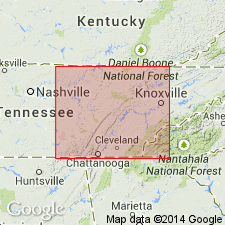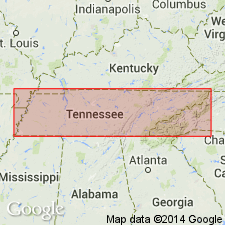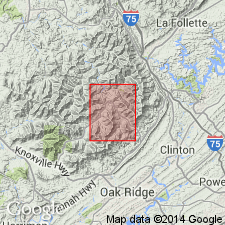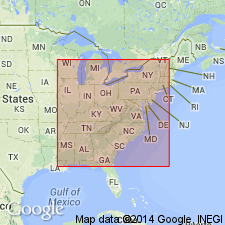
- Usage in publication:
-
- Redoak Mountain group
- Modifications:
-
- Named
- Dominant lithology:
-
- Shale
- Sandstone
- Coal
- AAPG geologic province:
-
- Appalachian basin
Summary:
Named for Redoak Mountain, southwestern part of Lake City quad, Anderson Co., eastern TN. Type section is the Cross Mountain section near Redoak Mountain. Includes Caryville sandstone, Fodderstack sandstone, Silvey Gap sandstone, and unnamed shale intervals. Consists of sandstone, shale, and coal. Thickness at type locality is 345 ft; ranges from 300 to 440 ft. Overlies the Graves Gap group; underlies the Vowell Mountain group. Report includes geologic map, correlation chart, measured sections, and columnar sections. Age is Pennsylvanian (Pottsville series).
Source: GNU records (USGS DDS-6; Reston GNULEX).

- Usage in publication:
-
- Redoak Mountain Formation
- Modifications:
-
- [Revised]
- Mapped
- AAPG geologic province:
-
- Appalachian basin
Summary:
(East-central and East sheets.) Redoak Mountain Formation. Shale, sandstone, siltstone, and several important coals; from Pewee coal to Windrock coal. Thickness 340 to 420 feet. Lies below Vowell Mountain Formation and above Graves Gap Formation. Age is Pennsylvanian.
[The Redoak Mountain Group of Wilson and others (1956) is reduced to formation rank. Its constituent formations, the Silvey Gap, Fodderstack, and Caryville, are also reduced in rank to members (not incl. on State geol. map). See also under Vowell Mountain and Graves Gap.]
Source: Publication.

- Usage in publication:
-
- Redoak Mountain Formation
- Modifications:
-
- Overview
- Dominant lithology:
-
- Sandstone
- Siltstone
- Shale
- Coal
- AAPG geologic province:
-
- Appalachian basin
Summary:
Consists of clayey to sandy, light-brown to dark-gray shale with coal beds and minor intercalated sandstone and siltstone; and yellowish-gray to yellowish-brown, fine- to medium-grained, thin-to thick-bedded sandstone, cross-bedded in part. Sandstones mostly lenticular. Thickness ranges from 340 to 460 ft. Age is Middle Pennsylvanian.
Source: GNU records (USGS DDS-6; Reston GNULEX).

- Usage in publication:
-
- Redoak Mountain Formation*
- Modifications:
-
- Revised
- AAPG geologic province:
-
- Appalachian basin
Summary:
Redoak Mountain Formation used in TN. Includes Caryville, Fodderstack, and Silvey Gap Sandstone Members, and Magoffin Member. Includes strata previously assigned to the Scott Formation or Shale (abandoned herein). Also includes strata previously assigned to Hignite Formation (abandoned herein); Magoffin Member of Hignite reassigned to Redoak Mountain. Upper part of Redoak Mountain includes strata previously assigned to Bryson Formation (abandoned herein).
Source: GNU records (USGS DDS-6; Reston GNULEX).
For more information, please contact Nancy Stamm, Geologic Names Committee Secretary.
Asterisk (*) indicates published by U.S. Geological Survey authors.
"No current usage" (†) implies that a name has been abandoned or has fallen into disuse. Former usage and, if known, replacement name given in parentheses ( ).
Slash (/) indicates name conflicts with nomenclatural guidelines (CSN, 1933; ACSN, 1961, 1970; NACSN, 1983, 2005, 2021). May be explained within brackets ([ ]).

